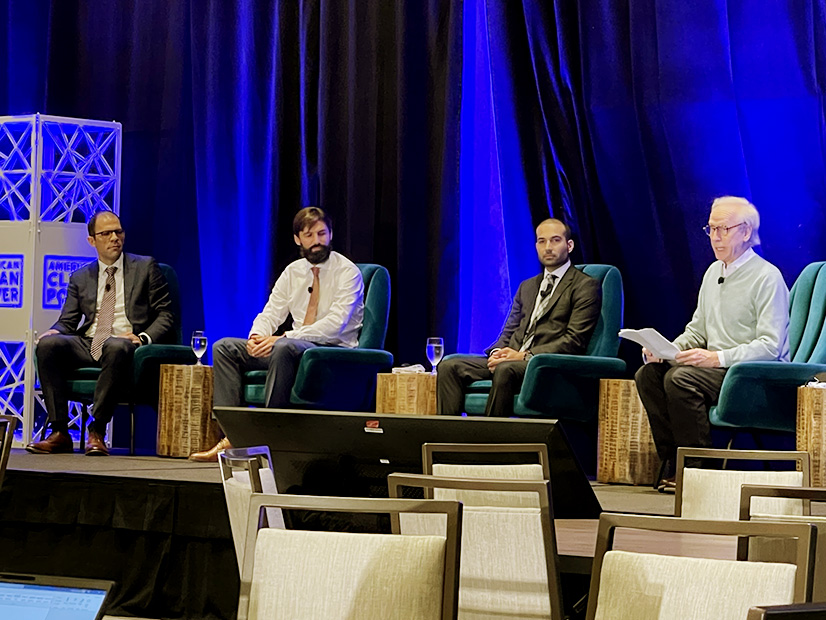
BOSTON — When Avangrid Renewables (NYSE: AGR) and Copenhagen Infrastructure Partners began talking to banks about financing their Vineyard Wind project back in 2019, more than 60 institutions took the company’s calls.
“We explored all the possibilities, and we saw so much interest,” CFO Álvaro Ortega Sebastián said.
The lenders’ ardor was not dampened when the Trump administration, also in 2019, postponed Vineyard Wind’s final environmental impact statement to conduct an expanded analysis of “cumulative impacts” from the multiple offshore projects proposed for New England.
The 800-MW project, 15 miles off the coast of Martha’s Vineyard, eventually narrowed the group of banks to nine. When Vineyard Wind wanted to close this year, the lineup was intact, Sebastián told the American Clean Power Association’s Offshore WINDPOWER 2021 conference last week.
“We came back in 2021 with the same group just to give them the opportunity to come up to the market with us at the same [interest rates and other terms] that we thought we should go out with, and they were all able to be there,” Sebastián said.
In September, Vineyard Wind I became the first commercial-scale offshore wind project in the U.S. to achieve financial close, having raised approximately $2.3 billion in construction and term loan financing from nine banks.
While developers still face challenges in financing OSW projects, lenders are eager to get involved, Sebastián and other speakers told the conference.
Atlantic Shores is further back in the development cycle than Vineyard Wind I. In July, it was awarded a contract by the New Jersey Board of Public Utilities to develop 1,510 MW in OSW energy. A joint venture between EDF Renewables North America and Shell New Energies US (NYSE:RDS.A), its lease area is located approximately 10-20 miles off the coast of New Jersey between Atlantic City and Barnegat Light.
Joris Veldhoven, the company’s commercial and finance director, told the conference the company would explore equity financing as well as “various forms of debt,” and export credit agencies — which provide loans, loan guarantees and insurance to promote exports — over the next two-plus years.
Given that Vineyard Wind encountered a situation where it had to stop and start again, Sebastián said by beginning the process with the banks in 2019, it was able “to reduce most of the work” as it moved forward this year.
“There’s a lot of back and forth between all the parties involved to negotiate the term price, so the earlier you start, the better,” Sebastián said. “But not too early because things can change over time.”
Mayflower Wind is developing a lease area 30 miles south of Martha’s Vineyard and 20 miles south of Nantucket that it hopes will generate 2,000 MW by the mid-2020s. It is owned by Shell and Ocean Winds, a joint venture by EDP Renewables and ENGIE.
CFO Justin Johns said the companies’ balance sheets and existing banking relationships “gives us a lot of flexibility as to when and how we execute.
“I would expect that we’re going to use non-recourse project financing similar to how we’ve done in Europe, and that will involve working to achieve the most competitive terms in the market,” Johns said. Non-recourse debt, such as a typical home mortgage, is secured by collateral; lenders cannot go after the borrower’s other assets in the event of a default.
OSW projects also currently qualify for an investment tax credit of 30% as long as construction starts by the end of 2025. U.S. Sen. Ed Markey (D-Mass.) introduced a bill in September that would create a 30% investment tax credit for American manufacturers to produce qualified OSW components and dedicated vessels. There would also be production tax credits for select OSW components to “prevent bottlenecks” in the supply chain. (See related story, Offshore WINDPOWER 2021 Conference Briefs: Oct 13-14, 2021.)
Markey’s legislation could get folded into the budget reconciliation bill Democrats are trying to push through Congress. However, Johns said any legislation passed could be a net benefit to the OSW industry if it accounts for all the variables, including the industry’s relative immaturity.
“It depends, but it should be a net benefit if it’s structured right with a view for offshore wind in recognition of where we are with the supply chain,” Johns said. “It needs to recognize U.S. offshore wind is at a much earlier stage. It depends on how that bill is implemented at the agency level. There definitely is potential there, but it needs to be done right.”
